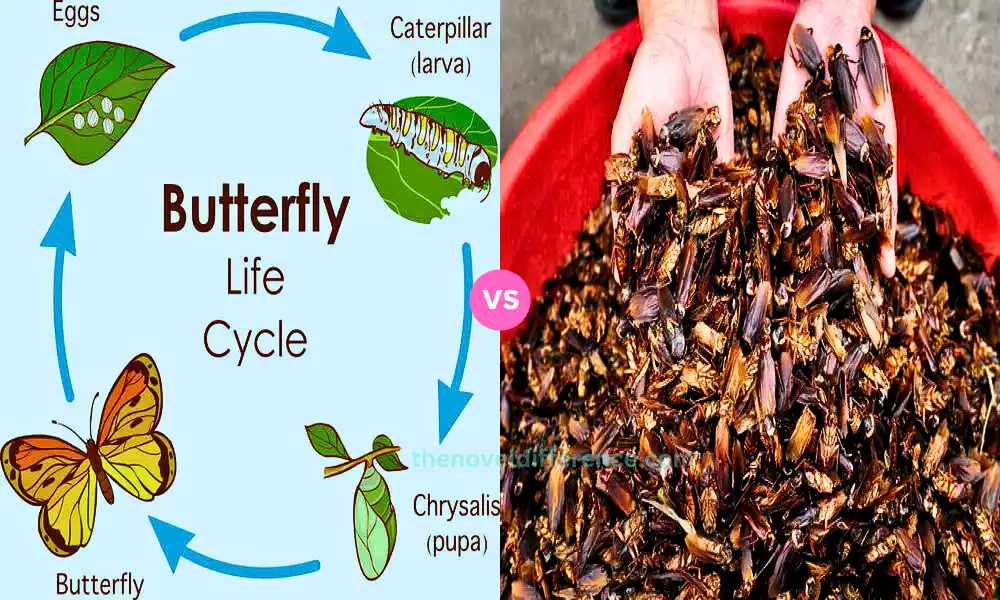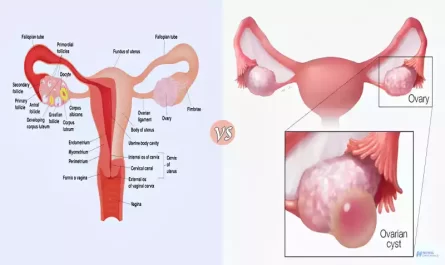The life cycles of various creatures exhibit fascinating transformations. Two such animals Life Cycle of Butterfly and Cockroach. Despite their differences in appearance and behavior, they share intriguing life cycles that undergo several distinct stages. In this article, we’ll delve deep into the Life Cycle of Butterflies and cockroaches to highlight each stage and its remarkable changes.
A brief overview of life cycles in the animal kingdom
Animal life cycles vary significantly and can generally be divided into two main groups. direct development and metamorphosis:
1. Direct Development: The young offspring resemble the adults from the time of hatching or birth. There are no distinct metamorphic stages, and the young gradually grow and mature into adults. Many vertebrate animals – from mammals, birds, and reptiles alike – as well as invertebrates, follow an evolutionary trajectory throughout their lives.
Example: Humans have a direct life cycle where newborns (babies) resemble adult humans and gradually grow and develop into adults over time without undergoing significant morphological changes.
2. Metamorphosis: Metamorphosis in animal terms refers to the process by which organisms transform as they experience developmental growth during their lives. This type of life cycle is most commonly observed in insects and amphibians.
a. Incomplete Metamorphosis: Life comprises three stages egg, nymph, and adult. Nymphs resemble adults but lack certain features, and they undergo a series of molts to reach the adult stage.
Example: Grasshoppers have an incomplete metamorphosis life cycle. Their young, called nymphs, look like small versions of adults and gradually grow and molt until they reach adulthood.
b. Complete Metamorphosis: At each stage of metamorphosis in insects with complete metamorphosis, their lives typically follow four distinct phases. From egg through larva (caterpillar or grub), pupa (chrysalis or cocoon), to adulthood. Each stage features specific structures and functions; thus the transitions from one stage to another occur rapidly and dramatically.
Example: Butterflies and moths undergo complete metamorphosis. A caterpillar emerges from its egg to look completely distinct from an adult butterfly. It pupates within a chrysalis, and after metamorphosis, emerges as an adult with wings.
Note that these categories are broad; there may be differences and complexities within the individual life cycles of different animal species. Exploring their incredible life cycles demonstrates just how diverse nature truly is, showing all its diverse strategies for survival in its environment and reproduction.
Introduction to the butterfly and cockroach as examples
Introduction: The butterfly and cockroach are two fascinating and vastly different examples of insects, each showcasing unique characteristics and life cycles within the vast animal kingdom. These insects belong to the Insecta class, one of the most successful and diverse groups of organisms on Earth. Despite being insects, their life cycles and ecological roles are markedly distinct, reflecting their evolutionary adaptations to various environments and survival strategies.
The Butterfly: Butterflies are among the most enchanting and colorful insects, captivating human hearts with their delicate beauty and graceful flight. These insects undergo a mesmerizing process of metamorphosis, transforming from a tiny egg into a stunning adult butterfly. Their life cycle, known as complete metamorphosis, involves four distinct stages: egg, caterpillar (larva), chrysalis (pupa), and adult.
Egg stage: The egg stage begins when a female butterfly lays her eggs on suitable host plants. From these seemingly insignificant eggs emerge voracious caterpillars, the larval stage. The caterpillar’s primary focus is eating and growing, shedding its exoskeleton multiple times as it increases in size.
After reaching: After reaching its maximum size, the caterpillar forms a protective chrysalis around itself, where it undergoes a remarkable transformation within. Finally, the adult butterfly emerges from the chrysalis, showcasing its vibrant wings and taking flight, participating in pollination, and contributing to the biodiversity of ecosystems.
The Cockroach: Cockroaches are often perceived as resilient and adaptable pests, surviving in various environments and climates worldwide. Cockroaches undergo a life cycle known as incomplete metamorphosis, characterized by three stages: egg, nymph, and adult.
The cockroach life cycle starts with the female cockroach laying eggs in sheltered locations. From these eggs hatch nymphs, resembling smaller versions of adult cockroaches with underdeveloped wings and reproductive structures.
As they grow, Nymphs go through a series of molts where they shed their exoskeletons. This continues until they reach adulthood. Cockroaches, unlike butterflies, do not have a pupal phase.
They continue molting and develop into sexually mature adults. Adult cockroaches are equipped with wings, enabling them to disperse and find new habitats while scavenging for food sources.
Cockroaches are often considered pests because they live in unclean environments. However, cockroaches have a very important ecological role. They decompose organic matter and contribute to the nutrient cycle within their ecosystem.
We will delve into the intricate details of the life cycles of butterflies and cockroaches, exploring their respective metamorphic processes, ecological significance, and the importance of understanding their roles in maintaining the delicate balance of nature.
The Life Cycle of a Butterfly
The life cycle of a butterfly is a captivating example of complete metamorphosis, showcasing a remarkable transformation from an egg to a beautiful and graceful adult butterfly.
This process consists of four distinct stages: egg, caterpillar (larva), chrysalis (pupa), and adult. Each stage serves a specific purpose in the development and survival of this extraordinary insect.
1. Egg Stage: The butterfly life cycle begins when a female butterfly lays her eggs on suitable host plants. The eggs are usually small, round, and often laid in clusters, attached to leaves or stems. Each species of butterfly has an ideal host plant that it prefers for its egg to hatch from; selecting this host is key for its survival as a caterpillar will emerge later from it.
When incubated inside an egg, embryonic development takes place inside it as preparations are made for its next stage in life. The duration of the egg stage varies among different butterfly species and environmental conditions but typically lasts for a few days to a couple of weeks.
2. Caterpillar (Larva) Stage: After the egg hatches, a tiny caterpillar emerges, also known as the larva. The caterpillar is the growth stage of the butterfly and its primary focus is to eat and grow rapidly. It has a voracious appetite and feeds on the leaves of its host plant. The caterpillar molts several times during this stage, shedding its exoskeleton to accommodate its increasing size.
Caterpillars have specialized mouthparts adapted for chewing and can consume large quantities of plant material. As it grows, a caterpillar stores energy in the form of nutrients for later transformation.
The duration of the caterpillar stage varies depending on the butterfly species, host plant quality, and environmental factors, typically lasting for a few weeks.
3. Chrysalis (Pupa) Stage: Once a caterpillar reaches maximum size, it enters what’s known as the chrysalis or pupa stage of its life cycle. The caterpillar attaches itself to a suitable surface, such as a leaf or twig, and spins a silk pad to which it attaches its last pair of prolegs. Then, it sheds its outer skin for the final time, revealing the chrysalis beneath.
Caterpillars undergo a dramatic metamorphosis process as their bodies change dramatically. Within the protective enclosure of the chrysalis, the caterpillar’s tissues break down and reorganize, reshaping the body into the adult butterfly form.
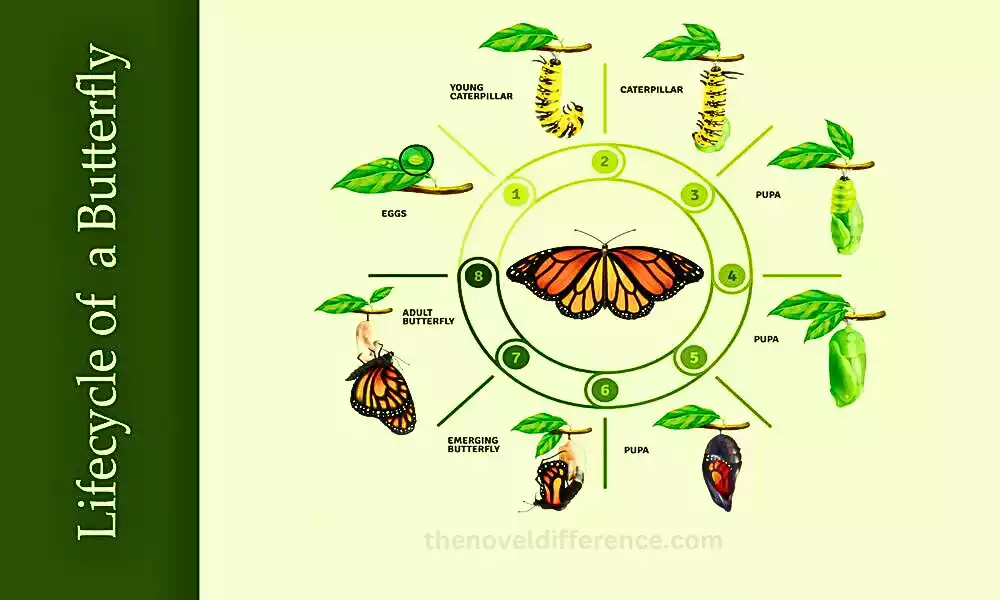
The chrysalis is usually camouflaged, helping to protect it from predators during this vulnerable period. Pupal stage duration depends on both butterfly species and environmental conditions; its duration could range anywhere from several days to several months.
4. Adult Stage (Butterfly): The adult butterfly emerges from the chrysalis, completing its incredible transformation. The newly emerged butterfly pumps fluid into its wings, expanding and drying them, allowing it to become strong and capable of flight. The adult butterfly’s primary objective is to find a mate and reproduce, thus continuing the life cycle.
Adult butterflies possess special mouthparts called proboscis that enable them to feed on nectar from flowers and pollinate, thus playing an integral part in plant reproduction and biodiversity maintenance.
By moving from flower to flower in search of food sources, adult butterflies play a critical role as pollinator organisms by contributing significantly to ecosystem biodiversity preservation.
An adult butterfly’s life cycle typically lasts several days to several weeks depending on species and environmental conditions. During this period, the butterfly may engage in courtship behaviors, mating, and laying eggs, starting the cycle anew.
In conclusion, the life cycle of a butterfly is a wondrous process that showcases the beauty of nature’s transformational abilities. From a tiny egg to a magnificent adult butterfly, each stage serves a crucial purpose in the survival and perpetuation of this exquisite insect species.
Egg Stage
The egg stage is the first phase in the life cycle of a butterfly and marks the beginning of its remarkable transformation. As part of her first step, a female butterfly will lay its eggs on an appropriate host plant that will ensure the survival and development of any caterpillar that emerges from these eggs.
Egg Appearance and Characteristics:
Butterfly eggs tend to be small and round or oval-shaped; their colors and sizes depend upon which butterfly species has laid them. The eggs are usually attached to leaves, stems, or other parts of the host plant. Female butterflies have specialized structures called ovipositors, which they use to carefully deposit the eggs on or near the chosen host plant.
The eggs’ shape, color, and location can vary greatly between different butterfly species. Some butterfly eggs may be smooth, while others might have intricate patterns or textures, providing camouflage and protection from predators.
Egg Laying and Host Plant Selection:
The process of egg-laying, known as oviposition, is a critical behavior for female butterflies. They carefully select suitable host plants for laying their eggs. Each butterfly species has specific preferences for host plants, as the caterpillars that will hatch from the eggs need to consume these plants for their survival and growth.
The selection of appropriate host plants ensures that the caterpillars have a readily available food source once they hatch, and it significantly impacts the butterfly’s ability to reproduce successfully.
Egg Development and Duration:
Once the eggs are laid on the host plant, the development of the embryo begins within the egg. The time taken for eggs to hatch depends upon varying environmental conditions such as temperature and humidity as well as species-specific traits such as butterflies.
Some species’ egg stages last only several hours while it could take several weeks for others. During this period, the egg remains dormant as the embryo inside undergoes initial development.
Protection and Predation:
Butterfly eggs are vulnerable to various environmental factors and predators. Female butterflies increase their odds of survival by laying multiple eggs at once on various parts of a host plant’s foliage, increasing the odds that some will hatch successfully into caterpillars.
Even with such adaptations, many butterfly eggs remain vulnerable to being consumed by insects, birds, or other predators that feed off of them. Additionally, adverse weather conditions or unsuitable environments can also impact egg survival rates.
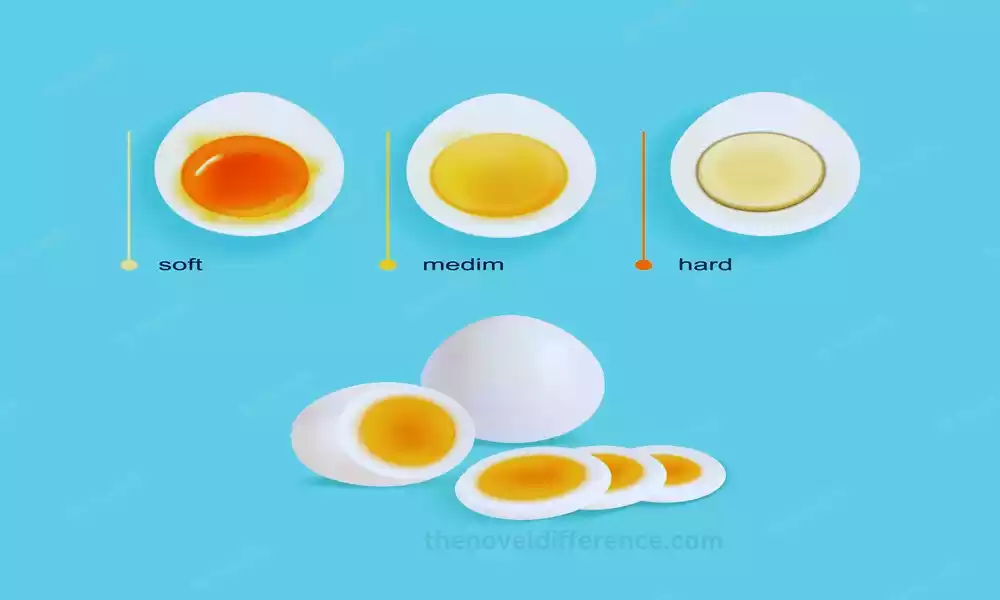
The egg stage of a butterfly’s life cycle is critical, providing the foundation for further stages in its metamorphosis process. The survival and successful hatching of eggs is essential for the continuity of butterfly populations and their contribution to the biodiversity and ecological balance of their respective habitats.
The Life Cycle of a Cockroach
The life cycle of a cockroach is an example of incomplete metamorphosis, characterized by three distinct stages: egg, nymph, and adult. Unlike complete metamorphosis seen in butterflies, cockroaches undergo gradual changes as they develop into adults, resembling miniature versions of adult cockroaches as nymphs.
- Egg Stage: The cockroach life cycle begins with the egg stage. Female cockroaches produce egg cases called oothecae, which contain multiple eggs. The female deposits the ootheca in hidden and sheltered locations, such as cracks, crevices, or other protected areas. The number of eggs in each ootheca varies among different cockroach species. The ootheca serves as a protective capsule for the eggs, shielding them from external threats and desiccation. The incubation period of the eggs depends on the cockroach species and environmental conditions but generally lasts a few weeks.
- Nymph Stage: Once the eggs within the ootheca are ready to hatch, nymphs emerge. Nymphs are miniature versions of adult cockroaches but lack fully developed wings and reproductive organs. These juvenile cockroaches resemble adult ones in appearance but may display different coloring or markings. Cockroach nymphs undergo several molts as they grow, gradually losing their exoskeleton as their size increases. The number of molts varies depending on the cockroach species and environmental conditions. After each molt, the nymph’s exoskeleton hardens and continues to increase until adulthood has been reached. Nymphs actively forage for food and are nocturnal, seeking shelter during the daytime. The nymphal stage can last from several days up to several months depending on your species of fly.
- Adult Stage: Once nymphs reach sexual maturity and complete their final molt, they transform into adult cockroaches with fully developed wings and reproductive organs that enable reproduction – thus perpetuating life cycles and continuing life cycles. Adult cockroaches possess wings that allow them to travel short distances; not all species, however, have this capacity. Cockroaches tend to be nocturnal animals that gather food, water, and shelter at night while hiding during daylight hours within cracks and crevices. Cockroaches live for several months or even several years when conditions allow, depending on the species.
- Reproduction and Life Cycle Continuation: Adult cockroaches engage in mating behavior, with females producing oothecae that contain eggs. The females then deposit the oothecae in suitable locations to ensure the survival of the next generation. Cockroaches are well known for their agility and resilience, enabling them to thrive in all sorts of climates and environments. Their scavenging nature and ability to feed on a wide range of food sources contribute to their survival and persistence in urban and natural habitats.
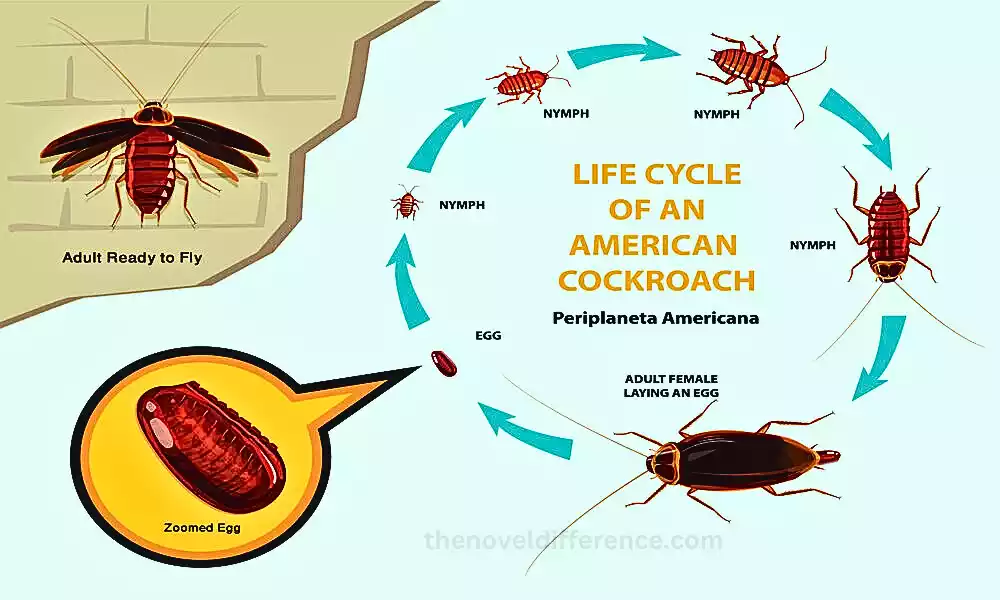
The life cycle of a cockroach is an example of efficient reproduction and adaptation strategies, allowing them to maintain their populations and occupy diverse niches in the ecosystem. Due to their association with unsanitary environments, cockroaches have earned themselves an unfavorable reputation and can become pests in human dwellings.
Egg Stage
Egg stages represent the initial phase in cockroach life cycles and play an essential part in species survival; female cockroaches lay eggs that ensure the development of future generations of insects.
- Egg Appearance and Characteristics: Female cockroaches produce egg cases called oothecae, which contain multiple eggs. The appearance and size of the ootheca vary among different cockroach species. Oothecae are often dark brown or black and have a tough, leathery outer casing that protects the eggs within. The shape and size of the ootheca are species-specific. Some oothecae are elongated and cylindrical, while others are more oval or rectangular. Each ootheca can contain anywhere from a few dozen to several hundred eggs, depending on the cockroach species.
- Egg Laying and Ootheca Placement: After mating, female cockroaches carry the developing ootheca with them until it is ready to be deposited. The female usually selects a hidden and protected location to deposit the ootheca, ensuring the safety of the eggs from predators and environmental threats. Common hiding spots for oothecae include cracks and crevices, wall voids, behind furniture, and other concealed areas. The female may use her mouthparts or specialized structures at the rear of her abdomen to attach the ootheca to a surface, securing it in place.
- Incubation and Development: Once the ootheca is deposited in a suitable location, the eggs within it begin their development. Temperature, humidity, and species all influence how quickly eggs hatch – incubation could last from several days up to several months in ideal circumstances.
- Hatching and Nymphs: After the incubation period, the eggs hatch, and nymphs emerge from the ootheca. Nymphs are young cockroaches that look similar to adults but are smaller and lack fully developed wings and reproductive organs. As young female nymphs, they rely heavily on their environment for sustenance such as food, water, and shelter. Nymphs undergo a series of molts as they grow, shedding their exoskeletons to accommodate their increasing size. Each molt results in the development of more adult-like features, including wing pads, which gradually develop into fully functional wings.
- Importance of the Egg Stage: The egg stage is vital for the survival and reproduction of cockroach species. Female cockroaches play a significant role in the successful development of their offspring by depositing the oothecae in safe and concealed locations. Cockroaches are notoriously fast reproducers; just one female can produce multiple eggs over her lifetime and thus produce many offspring. This reproductive strategy allows cockroaches to maintain their populations and quickly adapt to various environments.
The high reproductive capacity of cockroaches also contributes to their status as common household pests. Their ability to reproduce rapidly and their adaptability to different conditions make them challenging to control once they infest indoor spaces. Effective pest management strategies often focus on disrupting their egg-laying and breeding cycle to prevent their population growth.
Comparison of the Life Cycle of Butterfly and Cockroach
Butterfly and cockroach life cycles demonstrate two different forms of metamorphosis – complete for butterflies and incomplete for cockroaches.
Let’s compare the life cycles of these two fascinating insects:
- Metamorphosis Type:
Butterfly: Butterflies undergo complete metamorphosis, which involves four distinct stages: egg, larva (caterpillar), pupa (chrysalis), and adult. Each stage is dramatically different from the others, and the transformation is complete.
Cockroach: Cockroaches undergo incomplete metamorphosis, with three stages: egg, nymph, and adult. The nymphs resemble miniature versions of adult cockroaches and gradually develop into the adult form. - Developmental Stages:
Butterfly: The butterfly life cycle consists of four stages: egg, caterpillar, chrysalis, and adult. Each stage serves a specific purpose in the development and survival of the butterfly.
Cockroach: The cockroach life cycle consists of three stages: egg, nymph, and adult. Nymphs go through molts as they grow, gradually resembling adult cockroaches. - Morphological Changes:
Butterfly: The most striking morphological changes occur during the transformation from caterpillar to chrysalis and chrysalis to adult. The caterpillar turns into a pupa within the chrysalis, where the adult structures form.
Cockroach: Cockroaches experience gradual changes as they grow through the nymph stages. The nymphs resemble smaller versions of adults, undergoing molts to develop adult-like features. - Time Duration:
Butterfly: The duration of the butterfly’s life cycle varies depending on the species and environmental conditions. It can range from a few weeks to several months.
Cockroach: Cockroach life cycles are relatively shorter than butterflies. The time from egg to adult cockroach can be a few months, depending on species and environmental factors. - Ecological Significance:
Butterfly: Butterflies play a crucial role as pollinators, contributing to plant reproduction and maintaining biodiversity in ecosystems. They are also an essential part of the food web, serving as a food source for various predators.
Cockroach: Cockroaches contribute to ecosystem processes as decomposers, breaking down organic matter and recycling nutrients. While they are pests in human habitats, they play a role in the natural environment. - Adaptations:
Butterfly: Butterflies have evolved to specialize in pollination, with specific adaptations in their mouthparts, wings, and vision to facilitate their role as pollinators.
Cockroaches: Cockroaches are extremely adaptable insects that thrive in various environmental and habitat conditions, leading to their success in colonizing various habitats around the globe.
The life cycles of butterflies and cockroaches demonstrate different strategies for growth, development, and survival. Butterflies undergo complete metamorphosis, with a distinct pupal stage, while cockroaches undergo incomplete metamorphosis, with gradual changes through their nymph stages.
Both insects play important ecological roles, but butterflies are well known for their role in pollination, while cockroaches are recognized as decomposers.
Similarities between Butterfly and Cockroach Life Cycles
Despite their significant differences, the life cycles of butterflies and cockroaches also share some similarities.
These similarities highlight certain fundamental aspects of insect development and growth:
- Egg Stage: Both butterflies and cockroaches begin their life cycles with an egg stage. Female butterflies and cockroaches lay eggs as a means of reproducing and ensuring the continuation of their species.
- Vulnerable Early Stages: The early stages of development are particularly vulnerable. Cockroach eggs and young nymphs, and caterpillars of butterflies are much more vulnerable than adult stages to predation and environmental threats than any of their adults are.
- Growth and Molting: Both butterflies and cockroaches undergo a series of molts as they grow and develop. In butterflies, caterpillars molt multiple times, shedding their exoskeletons to accommodate their increasing size before forming the pupa. In cockroaches, nymphs also molt as they grow, shedding their exoskeletons to progress through their nymph stages.
- Multiple Life Stages: Both butterflies and cockroaches have multiple life stages before reaching adulthood. Butterflies go through the egg, caterpillar, pupa, and adult stages. Cockroaches progress through the egg, nymph, and adult stages.
- Ecological Importance: Both insects play essential ecological roles. Butterflies serve as pollinators, aiding in plant reproduction and contributing to ecosystem biodiversity. Cockroaches are decomposers. They break down organic material and recycle nutrients in the surrounding environment.
- Adaptability: Both butterflies and cockroaches are adaptable, allowing them to thrive and survive in diverse environments. While butterflies may have specific host plant preferences and habitat requirements during their larval stage, they are known for their ability to disperse and occupy various ecosystems. Cockroaches are also adapted to urban environments.
- Short Lifespan: Butterfly and cockroach lifespans are relatively short compared to other organisms. Most butterfly species reach adulthood in a matter of weeks. Adult cockroaches can live anywhere between two months and one year.
It’s important to recognize that, despite their similarity in life cycles and ecological functions, they have distinct life cycles. This is due to the various types of metamorphosis. These differences significantly shape their behaviors, adaptations, and contributions to the ecosystems they inhabit.
Cockroach’s Ecological Significance
Cockroaches, despite their reputation as household pests, hold significant ecological importance in various ecosystems. Environmental services provide vital environmental services that maintain ecological equilibrium while performing essential functions that contribute to overall ecosystem health.
Here are some key aspects of a cockroach’s ecological significance:
- Decomposers: Cockroaches are efficient decomposers, feeding on decaying organic matter, such as dead plants and animals. They break down this organic material into smaller particles, aiding in the process of decomposition. By accelerating the breakdown of dead matter, cockroaches play a vital role in nutrient cycling and recycling within ecosystems. This helps enrich the soil with essential nutrients, benefiting plant growth and supporting the health of other organisms within the ecosystem.
- Soil Aeration: As cockroaches burrow and move through the soil, they contribute to soil aeration. This process improves the soil’s structure, allowing better water infiltration and root penetration for plants. Proper soil aeration is critical for promoting healthy plant growth and enhancing overall soil health.
- Food Source for Predators: Cockroaches provide food sources to many predators such as birds, rodents, and reptiles; thus supporting the reproduction and survival of many higher up on the food chain. The availability of cockroaches as prey ensures the sustenance of predator populations and helps maintain a balanced predator-prey relationship in the ecosystem.
- Scavengers: Cockroaches feed on various sources, such as fruits, vegetables, and organic materials such as paper pulp. As scavengers, they clean up organic debris, helping to reduce the accumulation of waste and detritus in their habitats. By consuming and processing these organic wastes, cockroaches play a crucial role in reducing the potential for disease transmission and improving the overall cleanliness of their environment.
- Food for Other Insects: Certain species of parasitoid wasps are dependent on cockroaches as hosts for their larvae to hatch out and feed on, eventually leading to their demise. Wasp eggs can be laid either inside the cockroach itself or directly onto its exterior surfaces; when these hatch out and feed upon it directly. While this may seem detrimental to the cockroach, it is an essential ecological interaction that helps regulate cockroach populations and maintains the balance of insect communities.
Cockroaches contribute to ecosystem functioning and health by participating in nutrient recycling, aiding in soil health, acting as prey for predators, cleaning up organic debris, and serving as hosts for certain insect species.
Recognizing the ecological importance of cockroaches is critical in understanding their roles within natural ecosystems and underscoring the significance of biodiversity preservation and ecological balance.
Conclusion
Butterflies and cockroaches both play important roles in ecosystems, contributing to overall equilibrium and environmental well-being. Butterflies, with their complete metamorphosis, serve as essential pollinators, facilitating plant reproduction and supporting the biodiversity of flowering plants. As part of the food web, they provide sustenance for numerous predators and serve as indicators of environmental health.
Cockroaches, with their incomplete metamorphosis, perform vital ecological functions as decomposers. They help break down decaying organic matter, recycling nutrients and enriching the soil. Cockroaches also act as a food source for various predators, contributing to the energy flow within ecosystems.
Despite their sometimes negative perception of household pests, cockroaches’ ecological significance cannot be overlooked. Their role as scavengers, cleaners, and soil aerators is crucial for maintaining ecosystem health and functioning.

